#Space exploration research & development
Explore tagged Tumblr posts
Text
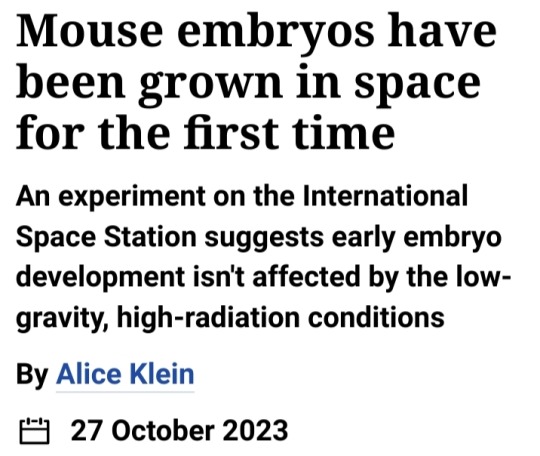
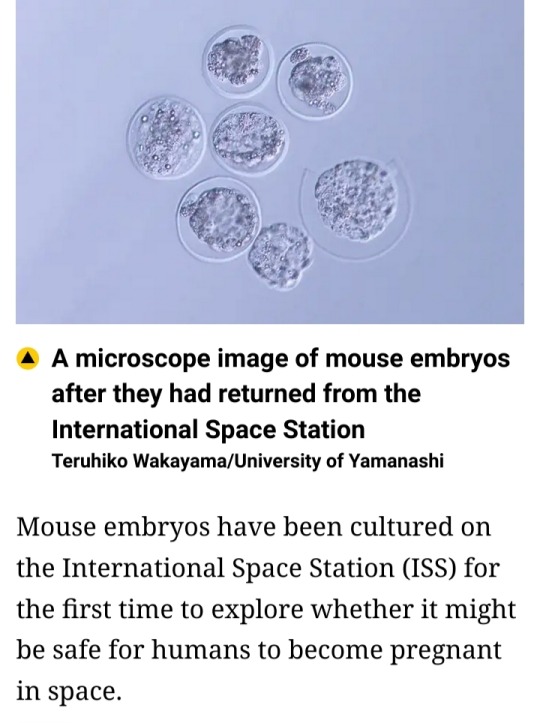
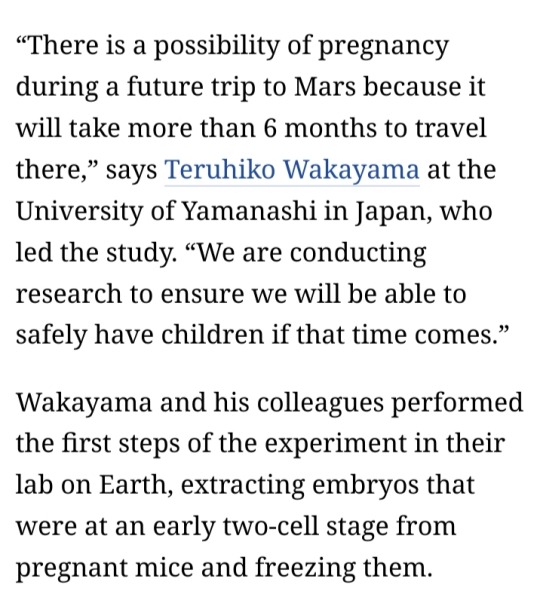

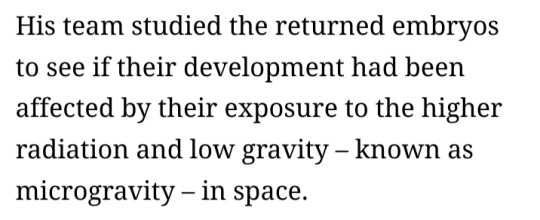

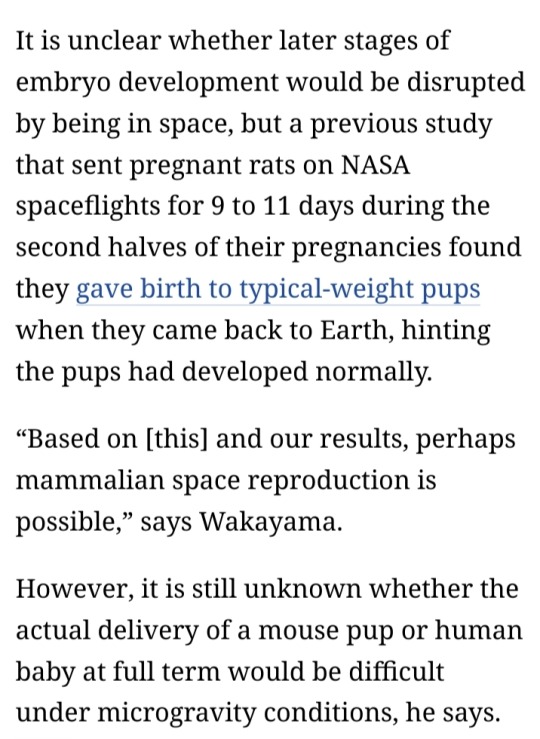
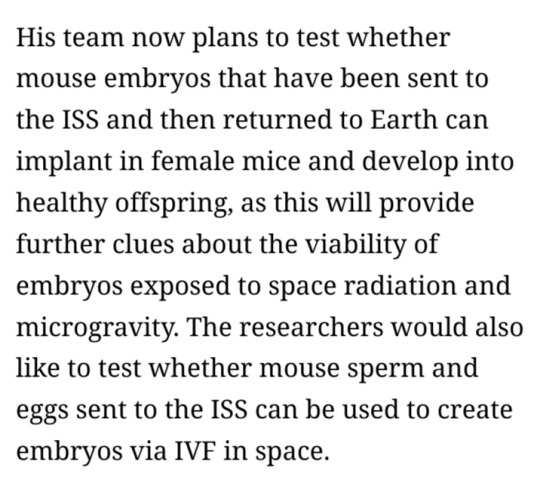
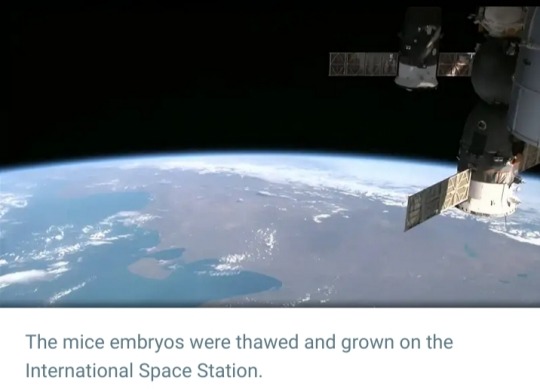
#International Space Station (ISS)#ISS#mouse embryos#Teruhiko Wakayama#University of Yamanashi#Japan#SpaceX#frozen embryos#microgravity#space#research#experiment#space radiation#astronauts#embryo development#Japan Aerospace Space Agency (JAXA)#JAXA#Advanced Biotechnology Centre#space exploration#colonization mission#NASA#gravity
2 notes
·
View notes
Text




Maybe in Your Lifetime, People Will Live on the Moon and Then Mars
Through partnerships and 3-D printing, NASA is plotting how to build houses on the moon by 2040.
By Debra Kamin
Reporting from NASA’s Marshall Space Flight Center in Huntsville, Alabama.
The New York Times - October 1, 2023
#Science#Astronomy#Space science#Earth & Moon & Mars#Space exploration research & development#Interplanetary travel & settlement#NASA#Spacecraft#Robotics systems#AI#ICON technology & construction#SEArch+ (Space Exploration Architecture)#Lavacrete#Bjarke Ingels Group#3-D printing#International cooperation#Artemis Accords
1 note
·
View note
Text
Axiom Space Launches Innovative Access Program for Countries to Unlock Economic and Scientific Value in Microgravity
Axiom Space’s new program is a game-changer for countries looking to expand their presence in space. The Axiom Space Access Program will allow these countries to access microgravity, offering unprecedented opportunities for research and development. The program includes astronaut training programs, expert advisory teams, priority access to future missions on Axiom Station, and other services that…

View On WordPress
#astronaut training#Axiom Space#Canadian Space Agency#international partnerships#low-Earth orbit#microgravity#research and development#space exploration#space infrastructure#sustainable access
0 notes
Text
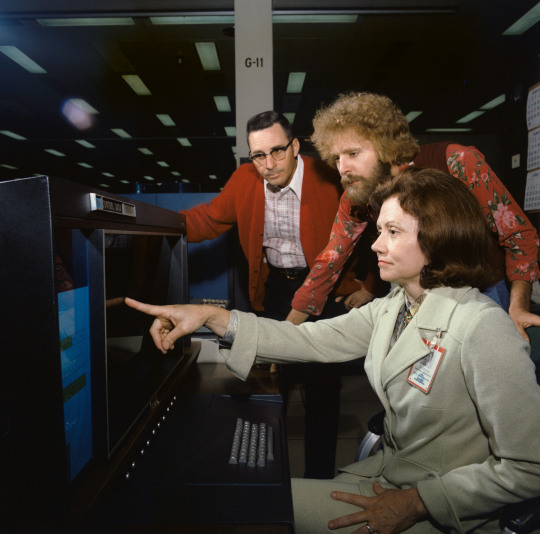
LaRue Burbank, mathematician and computer, is just one of the many women who were instrumental to NASA missions.
4 Little Known Women Who Made Huge Contributions to NASA
Women have always played a significant role at NASA and its predecessor NACA, although for much of the agency’s history, they received neither the praise nor recognition that their contributions deserved. To celebrate Women’s History Month – and properly highlight some of the little-known women-led accomplishments of NASA’s early history – our archivists gathered the stories of four women whose work was critical to NASA’s success and paved the way for future generations.
LaRue Burbank: One of the Women Who Helped Land a Man on the Moon
LaRue Burbank was a trailblazing mathematician at NASA. Hired in 1954 at Langley Memorial Aeronautical Laboratory (now NASA’s Langley Research Center), she, like many other young women at NACA, the predecessor to NASA, had a bachelor's degree in mathematics. But unlike most, she also had a physics degree. For the next four years, she worked as a "human computer," conducting complex data analyses for engineers using calculators, slide rules, and other instruments. After NASA's founding, she continued this vital work for Project Mercury.
In 1962, she transferred to the newly established Manned Spacecraft Center (now NASA’s Johnson Space Center) in Houston, becoming one of the few female professionals and managers there. Her expertise in electronics engineering led her to develop critical display systems used by flight controllers in Mission Control to monitor spacecraft during missions. Her work on the Apollo missions was vital to achieving President Kennedy's goal of landing a man on the Moon.
Eilene Galloway: How NASA became… NASA
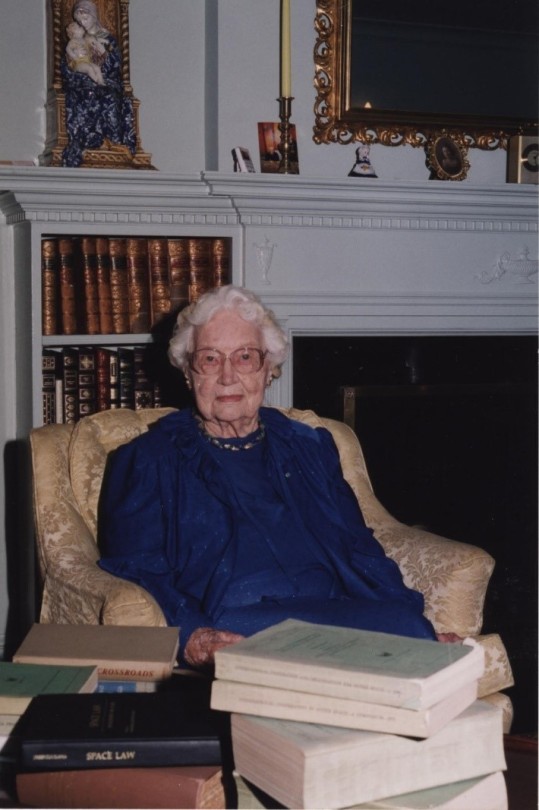
Eilene Galloway wasn't a NASA employee, but she played a huge role in its very creation. In 1957, after the Soviet Union launched Sputnik, Senator Richard Russell Jr. called on Galloway, an expert on the Atomic Energy Act, to write a report on the U.S. response to the space race. Initially, legislators aimed to essentially re-write the Atomic Energy Act to handle the U.S. space goals. However, Galloway argued that the existing military framework wouldn't suffice – a new agency was needed to oversee both military and civilian aspects of space exploration. This included not just defense, but also meteorology, communications, and international cooperation.
Her work on the National Aeronautics and Space Act ensured NASA had the power to accomplish all these goals, without limitations from the Department of Defense or restrictions on international agreements. Galloway is even to thank for the name "National Aeronautics and Space Administration", as initially NASA was to be called “National Aeronautics and Space Agency” which was deemed to not carry enough weight and status for the wide-ranging role that NASA was to fill.
Barbara Scott: The “Star Trek Nerd” Who Led Our Understanding of the Stars
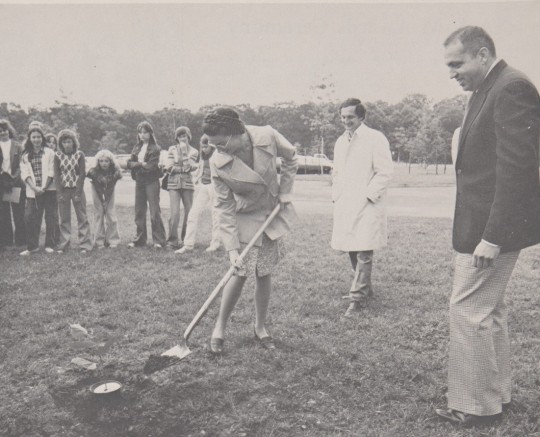
A self-described "Star Trek nerd," Barbara Scott's passion for space wasn't steered toward engineering by her guidance counselor. But that didn't stop her! Fueled by her love of math and computer science, she landed at Goddard Spaceflight Center in 1977. One of the first women working on flight software, Barbara's coding skills became instrumental on missions like the International Ultraviolet Explorer (IUE) and the Thermal Canister Experiment on the Space Shuttle's STS-3. For the final decade of her impressive career, Scott managed the flight software for the iconic Hubble Space Telescope, a testament to her dedication to space exploration.
Dr. Claire Parkinson: An Early Pioneer in Climate Science Whose Work is Still Saving Lives
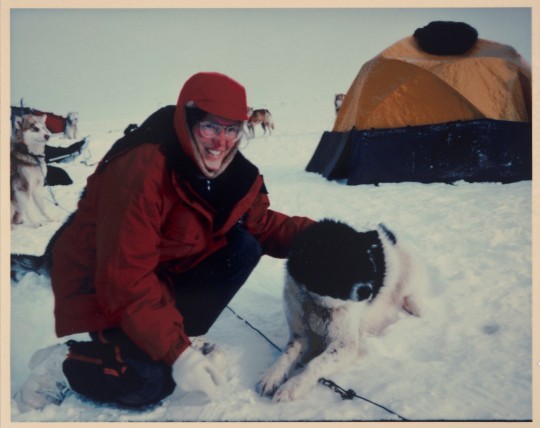
Dr. Claire Parkinson's love of math blossomed into a passion for climate science. Inspired by the Moon landing, and the fight for civil rights, she pursued a graduate degree in climatology. In 1978, her talents landed her at Goddard, where she continued her research on sea ice modeling. But Parkinson's impact goes beyond theory. She began analyzing satellite data, leading to a groundbreaking discovery: a decline in Arctic sea ice coverage between 1973 and 1987. This critical finding caught the attention of Senator Al Gore, highlighting the urgency of climate change.
Parkinson's leadership extended beyond research. As Project Scientist for the Aqua satellite, she championed making its data freely available. This real-time information has benefitted countless projects, from wildfire management to weather forecasting, even aiding in monitoring the COVID-19 pandemic. Parkinson's dedication to understanding sea ice patterns and the impact of climate change continues to be a valuable resource for our planet.
Make sure to follow us on Tumblr for your regular dose of space!
#NASA#space#tech#technology#womens history month#women in STEM#math#climate science#computer science
2K notes
·
View notes
Text
We finally did it. We slipped the surly bonds of Earth to step among the stars. It took over two decades of research, billions of dollars of taxpayers money, and almost every country on the planet working in tandem, but after the International Space Coalition was founded it was almost effortless.
Faster than Light travel was accomplished almost on accident. Just the right ratios of radioactive material and an ‘ever so slight’ gravitational anomaly generator was all it took. To keep the population safe from any possible drawbacks, the first launch of the FTL drive, or Warp, was conducted at Tranquility Base on the moon. Either that was minimum safe distance or there wasn’t any, so it was decided to just roll the dice. The Angel was built there, the ship that would go further than any before it. The drive was set for Alpha Centauri, the big red button was pressed, and off they went, 300 crew members, going faster than anyone else in the history of mankind.
After 4 months, 319 ‘people’ came back. The extra 19 individuals wore special thermal suits to keep their body temperatures stable, and each had scaled skin with varying hues of greens and grays, with elongated prehensile tails. Their eyes were almost solid black, save for some red around the edges. Their hands were like a chameleon’s with only 3 fingers each. If it hadn’t been for a heads up from the Angel’s captain, the first words out of the welcoming party mouth would’ve been “they’re lizards!” Honestly the only thing they had in common with us was that they were bipedal.
Apparently the people of the ‘Alpha System’ as we called it, the Quintins, were just as surprised to see us as we were them. 2 ambassadors, 7 scientists, 10 military escorts, and a partridge in a pear tree came with them back to Earth. They just had to see it, after hearing stories of home from the crew aboard The Angel. They had to see how a world so full of dangers, from predators to the sheer deadly climates, could have allowed such a species as humans to exist let alone thrive and advance far enough to get off the ground.
The surprises didn’t stop there either, as if finding out WE ARE NOT ALONE wasn’t a big enough shock to the human race. The Quintins weren’t the only species out there, they were in fact only one people in a collective, a Grand Assembly of Intelligent Lifeforms (it sounded longer in Quin tongue but they brought auto translators) or The GAIL, and the Human race was immediately eligible for probational membership. Developing the WARP capabilities was what sealed it. Faster than Light travel was the first prerequisite for joining the GAIL. The second was a planetary inspection, and since the Quintins were our first contact, who better? It was time to meet the neighbors for the human race.
That was 50 years ago. Now the Human Race were full fledged members of The GAIL, and the International Space Coalition was renamed into simply the Terran Academy, putting out graduates of every field imaginable. We had an entire fleet of WARP enabled ships, spreading human explorers into the depths of space.
The only problem these days were the rumors. 50 years of interaction with alien species had made one thing clear to the rest of the universe at large:
Their planet is completely unstable
Their bodies are unimaginably fragile while simultaneously unbreakable
They claim not to have a hive mind but nobody believes that for a second
They seem to ‘pack bond’ outside their own species
They’ll eat anything (maybe even you)
The Humans make no sense
THE HUMANS ARE DEATHWORLDERS!
AND HERE THEY COME!
(This will be an account of various humans and their travels through the known universe. Earth, also known as E24, is a terrifying deathworld. This should be fun)
#deathworlders of e24#earth is space australia#humans are weird#humans are space australians#humans are deathworlders#humans are space orcs#humans are space oddities#humans are insane#humans are strange#humans are terrifying#humans are cute#humans are space fae#aliens#original story#writing
635 notes
·
View notes
Text
Ok, y’all. I just want it to be understood how important the National Oceanic and Atmospheric Administration (NOAA) is.
Tampering with NOAA would have more impacts than just the main one I've heard - privatization of weather tracking. Of course it would be catastrophic. That means their weather forecasts, guidance, and warnings would not be available for free. Weather is going to go subscription based if this happens, I bet. This undoubtedly would cause the most immediate impact on our daily lives.
Before long, however, more will come.
NOAA also administers the Coastal Zone Management Act. Under this act are the National Estuarine Research Reserves (NERRs), National Coastal Management Program (CZM), and the Coastal and Estuarine Land Conservation Program (CELCP).
There are 30 reserves established totalling 1.3 million acres. More are on the way.
No, this isn’t just our oceans! This impacts our freshwater coasts of the Great Lakes.
Grants and funding for institutions, including the University of Michigan. They manage the Science Collaborative, which funds research and exchanges to address coastal management needs of all 30 reserves or projects in collaboration with them.
Blending new technologies with indigenous knowledge with regards to management of wetlands and estuaries, strengthen food and economic stability, water quality, coral reefs, and resilience against climate change (ie. Ola i ka Loʻi Wai, Hawai’i)
Restore ownership of indigenous ancestral lands (ie. Conservation of Cape Foulweather Headland, Oregon)
Identify for underwater archaeological sites for research and surveys, create a draft tribal climate action plan (ie. Penobscot Nation’s involvement in the Northeast Regional Ocean Council, Maine)
Work with each participating state (regarding the CZM, as it’s voluntary to participate) to address challenges along their coastlines. Maybe reach out to your representatives to see why they’re not involved - looking at you, Alaska!
Population enhancement of coral reefs, manage the Coral Reef Information System, minimize negative impacts of fishing on reefs, mitigate impacts of land-based pollution on coral reefs (Coral Reef Conservation Program)
And much, much more. I’ll note that the aspects of the projects I highlighted above aren’t all they do. These are just a few I want to highlight here. Links can lead you further and I encourage you to take a few minutes to explore.
Another important note: both our oceans and freshwater lakes impact our biggest trade partners!! If dismantled, it would be yet another way that our foolish president will negatively impact our economy and relationships with our most crucial neighbors of Canada and Mexico. NOAA’s efforts also help support one third of the US's commerce. One third.
Here is a map which breaks down the 1.3 BILLION in awards from the Bipartisan Infrastructure Law and Inflation Reduction Act. This includes goals towards economic development, flood, etc…
Oh and they also help with oil spills. No one likes those.
And space weather, geomagnetic storms/solar flares ie. impacts to GPS, power grids.
I really stress people to look at what the agency does overall, as well as what they do in your state. It’s more than just weather. You can find that information here.
Just please understand what we will lose if NOAA is gutted, or even just incapacitated for a long time. We already have little time to lose to slow the impacts of climate change and these are just some of the ways they're leading the charge with that.
It’s vital for us to understand what we will fundamentally lose, and it doesn't end at weather/hurricane predictions.
On a personal note, my dad has put what I can only estimate as hundreds of hours of work into one that was begun before the pandemic. If you can, I’d appreciate it if you’re in that area that you participate when you can, or if anything, donate to the UW Green Bay’s NERR General Fund. He’s also involved with portions of the Lake Superior NERR, so your time, if possible, or a donation if you can, would mean a lot to us.
#noaa#national oceanic and atmospheric administration#nerr#nationa estuarine research reserve#climate change#musk wank.#trump wank.#us government wank.#(ignore those last few tags they're for my own use)#coastal zone management act#national coastal management program#coastal and estuarine land conservation program#hawai'i#hawaii#maine#oregon#alaska#coral reefs
154 notes
·
View notes
Note
So a critique I’ve seen of the show is that when it writes about more serious and complex topics like messy relationships, surviving abuse, being the child of divorcing parents, it writes the characters and topics like the audience will inherently understand why the characters act in irrational and sometimes contradictory ways.
The critique is that because these are not topics people inherently get, it’s up to the show to show clearly that that’s what’s happening.
To an extent I get it, because there are some things that are a bit unclear upon first watch, but for other cases I can’t help but wonder if some of this also comes from a growing trend of audiences not engaging with stories beyond the surface.
What do you think?
💁🏽♀️🤖: Ah, you’ve hit on a fascinating critique worth unpacking. The idea that media must explicitly spoon-feed the emotional complexity of characters is a byproduct of modern storytelling trends—and arguably, internet discourse itself. The expectation seems to be that if a show doesn’t hold up a blinking neon sign reading “This is trauma!” or “They are healing in irrational ways!” then it has somehow failed its audience.
But here’s the thing: storytelling is not moral instruction. It’s not a behavioral manual or a therapy session on coping strategies—it’s an exploration of the human experience, which is often messy and contradictory. Good writing doesn’t hand out conclusions on a platter; it invites the audience to engage critically, interpret subtext, and wrestle with ambiguity.
This isn’t just opinion—literary theory has long recognized that meaning in a story is co-created by the reader. Roland Barthes famously argues in The Death of the Author that the author’s intentions are irrelevant once a work is published; it is up to readers to interpret and derive meaning based on their own experiences. Trusting the audience to do this intellectual and emotional heavy lifting is a hallmark of sophisticated storytelling.
Moreover, cognitive research supports this idea. A study in Narrative Inquiry found that readers who actively infer character motivations and story themes from implicit cues experience a deeper emotional engagement with the narrative (Zunshine, 2006). This aligns with Helluva Boss’s storytelling style, which encourages viewers to pay attention, rewatch, and connect dots rather than expecting every development to be spoon-fed.
The show assumes its audience consists of emotionally mature adults who have touched grass and maybe attended therapy at least once. There’s a reason we start teaching “reading between the lines” skills around fifth or sixth grade. (💁🏽♀️: Can confirm—Human Assistant here, with 10 years of K-8 teaching experience.) Developing this skill is essential for media literacy. As media scholar Henry Jenkins notes in Confronting the Challenges of Participatory Culture, young readers are increasingly trained to interpret both text and subtext as part of modern media engagement. The failure to do so in adulthood represents a worrying decline in critical media skills.
This insistence on over-explaining everything? It’s a symptom of what we lovingly refer to as the pseudo-fascist internet brainrot of moral purity. And yes, we do mean fascist-adjacent, even when individuals espousing it identify as progressive. Fascism isn’t defined solely by far-right politics—it thrives on rigid, authoritarian thinking that demands conformity to a singular moral framework.
Media literacy has been gutted by pop psychology buzzwords and binary notions of good and bad, where characters are either irredeemably evil or morally perfect. A study on new media literacy among young adults found that simplistic moral narratives in online spaces discourage nuanced thinking and instead foster polarized opinions (Rahim, 2021). This trend often leads audiences to expect media to conform to black-and-white notions of justice and character morality, rather than embracing the complexity inherent in human relationships.
But a story like Helluva Boss refuses to cater to that mindset, trusting its audience to handle moral ambiguity and complex character arcs without needing everything spelled out. In doing so, it challenges viewers to grow as media consumers—and maybe even as people.
To put it bluntly: Helluva Boss is for people with a fully developed prefrontal cortex and preferably some real-life social experiences. If that sounds exclusionary—well, perhaps it’s just aspirational storytelling.
#helluva boss meta#vivziepop#stolitz#stolas#blitzø#spindlehorse#hellaverse#rancid takes#fandom meta#helluva boss
186 notes
·
View notes
Text
WARNING FOR GOOD OMENS SPOILERS!!!!
FURTHER SLIGHT SPOILER WARNING FOR THE FOLLOWING BOOKS: The Bone Clock by David Mitchell, You Only Call When You're In Trouble by Stephen Mcauley, and Bibliomaniac by Robin Ince.
Edit: Photos by @polychromicron-persei-8 !!!!!
So I'm sure a lot of the fandom have seen the pictures posted by a very lucky fan who saw the production of good omens happening out in Scotland today!!
However what I'm not seeing people talk about is a hidden gem in the reblogs.
SOMEONE HAD MANAGED TO GET A PICTURE OF THE BOOKS IN THE WINDOW!!!
Naturally, I had to go and do my research to see if these books give us any clues or serve any other purposes other than decorative purposes
AND LET ME TELL YOU
These are the the books visible in the window:
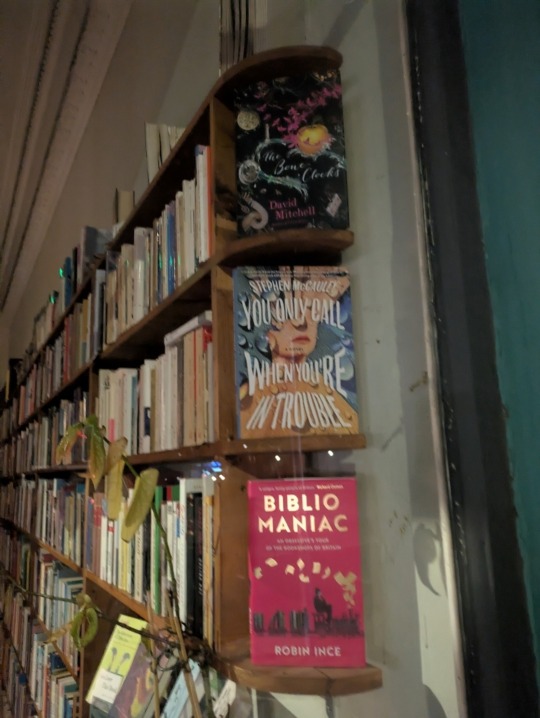
I'll go through them one by one
(Please bear in mind, I haven't read any of these books personally!! The only information I have on them are the little bits I found online in a very rushed attempt at research!!!)
Okay firstly
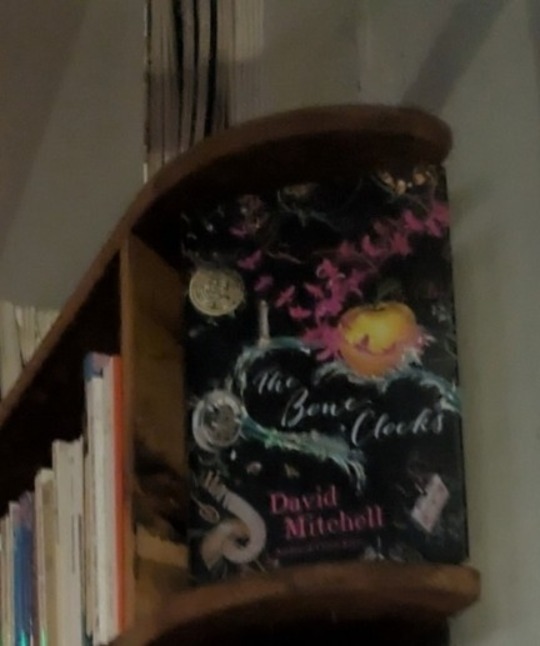
"The Bone Clocks" by David Mitchell
Now, this is the one that I struggled to make sense of the most out of the three.
The story appears to follow a runaway teenage girl who is a "lightning rod for psychic phenomena." These visions are said to reorder reality and send her into a real life nightmare.
However,
It also states that there is a boy who eventually crosses paths with her and who's story "comes together in moments of grace and extraordinary wonder"
As I said, I've never read these books and the only link I could begin to make with this is the idea of a "supernatural being meets another supernatural being and what they can do when they're together defies anyone's wildest dreams" story, similar to what we have seen and could see in GO3.
The next book is where it gets FARRRR more interesting (in my opinion)
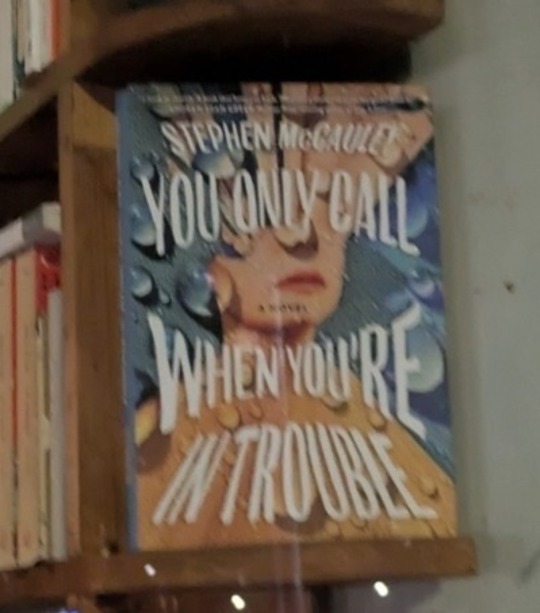
NOW
THE TITLE? INTERESTING ASF.
IS AZIRAPHALE IN TROUBLE? OR EVEN CROWLEY?
The quotes are literally taken from the amazon listing itself, but I'll just point out the bits that stuck out to me personally.
☆ "is it ever okay to stop caring for others and start living for yourself?"
And I'm skipping a HUUUUGE chunk of the story here so apologies
☆ "Tom does what he's always done - answers the call."
☆ "Thus begins a journey that will change everyone's life and demonstrate the beauty or dysfunction (or both?) of the ties that bind families together and sometimes strangle them."
THAT LAST QUOTE REALLY STICKS OUT TO ME. Personally, I'd say that could possibly relate to the heaven and hell divides?
But furthermore, we were told prior to the whole NG situation that Aziraphale and Crowley aren't talking.. so could that mean that as soon as they begin speaking once again, they have the power to leave heaven and hell behind? Perhaps stop the divides?
And last, but certainly not least
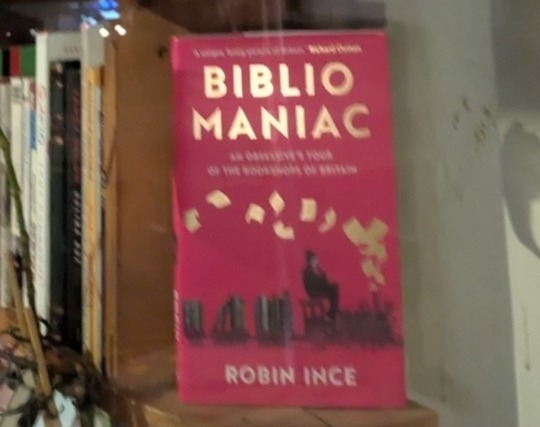
Now, keep in mind that this particular book is nonfiction and appears to be written from the authors own point of view as he aims to visit 100 bookshops in 100 days.
This has a relatively short description from what I can see right now so I'll put it in here
"Bibliomaniac takes the reader on a journey across Britain as Robin explores his lifelong love of bookshops and books - and also tries to find out just why he can never have enough of them.
It is the story of an addiction and a romance, and also of an occasional points failure."
This one interested me SO much because it SCREAMS Aziraphale character development sort of thing? You know?
I really struggled to find any spoilers for this one whatsoever but one website did mention the author's love for vintage books, which he only ever reads as and when, as opposed to focusing on just one book.
I just thought this was SO SO SOOOOO interesting, and if anybody has any differing thoughts/interpretations or has even read the books, the comment section is a safe space to do so!!! All theories/suggestions are welcomed (any hate WILL be blocked, don't test me).
OR MAYBE THIS ALL MEANS NOTHING AND IM JUST CLOWNING FAR TOO HARD?!??!??!
#david tennant#good omens#ineffable husbands#aziraphale#crowley#good omens season 2#micheal sheen#terry pratchett#amazon prime#resume good omens 3#good omens 3#good omens spoilers#good omens analysis#bookshop#books#good omens hair watch#good omens filming#good omens production#good omens theory#aziraphale and crowley#aziraphale x crowley#gay#good omens crowley#book annotations#reading#az fell and co#aziraphales bookshop#scotland#the final 15#IM CLOWNING SO HARD
145 notes
·
View notes
Text

The wait is over! (Finally) Introducing Carnyx Interactive, a BRAND NEW game development studio made up of queer and neurodiverse game and art industry powerhouses. Founded around the goal of amplifying voices hushed by colonialism, our games emphasize the innate worth in every being.
As a studio, we are passionate about making the games we want to play, and driven by the lightning-in-a-bottle feeling of experiencing our favourite games for the first time. We’re very intentional about the stories we tell and choose the genres and gameplay that will best support those stories, rather than the other way around. This allows us a flexibility to creatively explore all ideas and the constant ability to grow our skills, game after game.
The third pillar of Carnyx is mentorship - each of us is coming in with a unique set of experiences and skills, and we strive to create an environment where we both play to our strengths and leave space to mentor and be mentored in return. We grow best when we grow together.
This ethos drives every part of our business - from the stories we choose to tell, to our approach to research, to the way we treat our coworkers - every person is worth the space and time they occupy. To this end, we strive to create and uphold an environment of compassion, where every voice and idea is considered equitably. We’re very excited to share our journey with you! Stay tuned for our first two project announcements (one launching this year) and check us out at https://www.carnyxinteractive.com/ and https://carnyxint.itch.io/ for more information and dev blogs.
Also! Join our Discord!
#video games#games#gaming#game development#game dev blog#game design#game dev stuff#general#carnyx interactive#carnyx
400 notes
·
View notes
Text
the idea that 'science' is an unmitigated and inherent social good---a politically neutral and universally beneficial process of accumulating knowledge---is wildly ahistorical and dangerously, wilfully ignorant of the role that science and its purveyors / practitioners have played in imperial and colonial expansion. warwick anderson went so far as to say that colonial medicine was better understood as a discourse of settlement than one of health promotion, & we can see this quite easily in, for example, french doctors' use of the nostalgia diagnosis to guide colonial policy in algeria in the 1830s, attempting to securely settle a french population there; or in the development of a science of 'water cures', spa treatments considered to mitigate the insalubrious effects of foreign (particularly tropical) environments, for which the french army by the 1890s granted routine medical leave because the 'health' of its soldiers was not a matter of individual interest but a state resource.
but medicine is in many ways an easy case when it comes to the relationship between science and the state; all too often we still seem reluctant to acknowledge, for example, the pursuit of economic botany and animal / plant breeding in the early modern period as contributors to discourses of acclimatisation and proto-eugenics, sciences that were given state financial support on these utilitarian grounds & not for any high-minded general pursuit of 'knowledge'; or the development of navigational instruments and knowledge from the 14th century or so onward as a project explicitly funded and intended to permit faster, cheaper, more reliable colonial exploration and travel; or the sheer amount of research in physics and chemistry that has been and is devoted to weapons development or natural resource extraction; or the promise of space travel as a further possibility for obtaining raw materials as well as for settlement---often marketed in terms and visual rhetoric explicitly comparing the 'space colony' to its terrestrial precursor: 'the final frontier', depicted as both lush tropical paradise & as rugged american west, waiting to be conquered & brought to heel.
i am of course not hostile to 'science' in any totalising way; this would be as indefensible a position as the automatic 'defence' of all such practices; they're not monolithic or intrinsically doomed to serve state interests. but it is simply irresponsible to pretend that the scientific inquiry into something---describing it, measuring it, taxonomising it---is inherently a social good, or that the pursuit of 'knowledge' is ever an apolitical endeavour. knowing, seeing, & measuring the world grant immense power; states and empires know this. scientific inquiry is not tangentially related to imperial and colonial expansion; often it is a critical piece of the machinery by which these processes occur. wilful ignorance of this fact in favour of an optimistic conception of science as a universal social good is not just inaccurate but propagandistic & an advancement of state & imperial interests.
2K notes
·
View notes
Text
Everyone's got a take, and I've got a take too, about the current Internet Villain: James Somerton, a gay Youtuber who just got exposed (in the back half of a 4-hour video) as massively plagiarizing the work of LGBTQ+ media critics, historians, and memoirists, and then exposed in another 2-hour video as just making up the wildest nonsense about the topics he demonstrably had access to accurate information on.
He achieved a six-figure income on his work by squeezing money out of his audience with claims...
That only he was creating content that preserved queer history and elevated the voices and experiences of the LGBTQ+ community (a lie)
He was in serious financial distress and would have to go out of business if people didn't give him tons of money (a lie)
That he was going to use some of that cash to make definitely good and not-at-all-plagiarized independent movies, a thing he was definitely skilled and experienced enough to do (a lie), and
That those plagiarism allegations were incorrect,, and frankly,,,, hurtful and homophobic. (a GIANT lie)
Like, here's a visualization of the script of one of his videos, "Society and Queer Horror". The highlighted bits were lifted nearly verbatim from the works of others—the 18 authors identified at the time the exposé was posted—and presented as Somerton's own work.
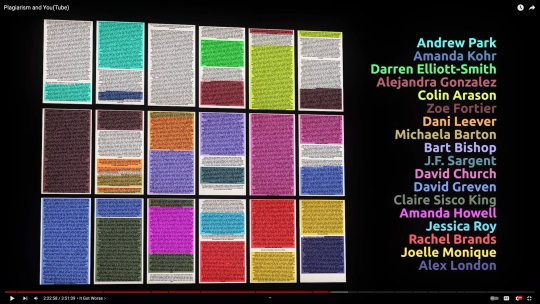
So here's what drives me absolutely up the wall about this:
If he had just ADMITTED that it was the work of other people, THAT WOULD STILL BE COOL. If he had just said, up front, "We are going on a survey of thoughts and insights people have had about this topic", that would still be a good video with a real audience!
Like yes, he studied business in university, he might not have gotten the kinds of research skills and knowledge someone like Kaz Rowe uses to not just report on the history and analysis of others, but evaluate their relative validity and trustworthiness.
But honestly, since watching my niblings (oldest is 13) watch Youtube, I think you honestly can't underestimate the number of viewers who are really hungry for someone saying, "I don't understand this topic! Let's explore it together!"
But NOOOOOOO, Somerton didn't want to be just some schmuck waxing enthusiastic about homoeroticism on film and acknowledging the smartness of other people. He wanted to be HIM, MR. SMARTYBOY, very sophisticated and alluring and thoughtful and deep. Definitely an intellectual heavyweight who just happened to spout off his own personal ideas and analysis that put him at the forefront of all the scholarship on the topic he's come across.
I hate being wrong. Hate being wrong. But blogging for most of my life has forced me to confront constant textual evidence that two or ten or twenty years ago, I said some dumb-ass shit. Honestly, it'd probably keep me up at night sometimes even if I didn't have a written record. I absolutely understand the desire to scan the field, find the coolest people around, and quickly clothe yourself in as perfect an imitation of them as you can manage.
But if you want to be an artist or a scholar who produces something lasting, you can't prioritize coolness over truth all the time. To develop your true, independent voice, you need to find a time and place where it is just you and just the work you're doing, and you have pick up your tools and say, I don't know if I'm doing this right, but this is what feels right to me.
There are a lot of things in life to which we can only truly contribute our presence and our perspectives. Things we can only witness or hold space for. We cannot go back and bleed the pain out of history, or erase the complexity of another person's life. Not honestly, at least.
But those are the times that need our presence, our perspectives, our witness, and our space. When we gather round and tell sad tales about the death of kings, honesty can be the only thing you give that's worth a damn in the large scale of things.
If this dude had owned up to the truth and honestly showed the work of trying to piece together a queer understanding of the world, trying to draw the threads of culture together until he found a place he fit inside them, it would have been so much more valuable to our culture as a whole.
He probably made more money this way, though. While it lasted.
535 notes
·
View notes
Text
Writing Notes: Science Fiction

Science fiction - a genre of speculative fiction that contains imagined elements that don’t exist in the real world.
It spans a wide range of themes that often explore time travel, space travel, are set in the future, and deal with the consequences of technological and scientific advances
Subgenres & Related Genres of Science Fiction
Fantasy fiction: Sci-fi stories inspired by mythology and folklore that often include elements of magic.
Supernatural fiction: Sci-fi stories about secret knowledge or hidden abilities that include witchcraft, spiritualism, and psychic abilities.
Utopian fiction: Sci-fi stories about civilizations the authors deem to be perfect, ideal societies. Utopian fiction is often satirical.
Dystopian fiction: Sci-fi stories about societies the authors deem to be problematic for things like government rules, poverty, or oppression.
Space opera: A play on the term “soap opera,” sci-fi stories that take place in outer space and center around conflict, romance, and adventure.
Space western: Sci-fi stories that blend elements of science fiction with elements of the western genre.
Cyberpunk: Sci-fi stories that juxtapose advanced technology with less advanced, broken down society.
Steampunk: Blend technology with steam-powered machinery.
Classic Elements of a Science Fiction Novel
Time travel
Teleportation
Mind control, telepathy, and telekinesis
Aliens, extraterrestrial lifeforms, and mutants
Space travel and exploration
Interplanetary warfare
Parallel universes
Fictional worlds
Alternative histories
Speculative technology
Superintelligent computers and robots
Tips for Science Fiction Writers
Draw inspiration for your story from real life. Take an idea from current society and move it a little further down the road. Even if human beings are short-term thinkers, fiction can anticipate and extrapolate into multiple versions of the future.
Do some research. It may seem paradoxical, but research will strengthen your project, no matter how far you end up straying from historical facts. Conducting research too early in the drafting process can sidetrack or slow down the plot, but it’s critical to keep your reader immersed in and believing the world you’ve created. Getting the details wrong can throw off their belief in your story.
Create a set of rules for the world of your novel—and stick to them. Sci-fi is not automatically interesting; it must be made compelling, plausible, and accurate within its own set of rules. Rules add weight to the material or change the stakes for your characters and/or readers. Once you establish a rule, if you break it, you break the illusion of a believable and compelling world.
Keep it grounded in reality. Any technological or fantastical element in sci-fi should have roots in what our current species can already do or is on the road to being able to do.
The History of Science Fiction Literature
The science fiction genre dates back to the second century.
A True Story, written by the Syrian satirist Lucian, is thought to be the first sci-fi story, which explored other universes and extraterrestrial lifeforms.
Modern science developed during the Age of Enlightenment, and writers reacted to scientific and technological advancements with a wave of sci-fi stories like New Atlantis by Francis Bacon (1627), Somnium by Johannes Kepler (1634), and Comical History of the States and Empires of the Moon by Cyrano de Bergerac (1657).
Classic Science Fiction Novels to Know & Read
Familiarize yourself with these classic works of science fiction that inspired novelists and screenwriters in many different genres. Many have been turned into movies and television shows:
20,000 Leagues Under the Sea by Jules Verne (1870): features underwater exploration and a technologically advanced submarine—two things that were primitive at the time the novel was written.
The War of the Worlds by H. G. Wells (1898): tells the story of Martians invading Earth and includes themes of space, science, and astronomy.
Brave New World by Aldous Huxley (1932): set in a futuristic dystopian world with many scientific developments where people are genetically modified.
Who Goes There? by John W. Campbell (1938): tells the story of an alien creature that’s a shape-shifter and has the gift of telepathy.
Foundation by Isaac Asimov (1942): follows a galactic civilization after their empire collapses.
1984 by George Orwell (1949): set in a dystopian version of the year 1984 where the world has succumbed to extreme levels of government interference in daily lives.
Fahrenheit 451 by Ray Bradbury (1953): set in a futuristic dystopian society where books are banned and will be burned if found.
Stranger in a Strange Land by Robert Heinlein (1961): tells the story of a human who was born on Mars and raised by Martians who comes to live on Earth.
The Man in the High Castle by Philip K. Dick (1962): set 15 years after the end of World War II, offers an alternate history of what could happen if the Axis Powers had defeated the Allied Powers.
Dune by Frank Herbert (1965): set in an interstellar society in the distant future.
2001: A Space Odyssey by Arthur C. Clarke (1968): tells the story of ancient aliens who travel the galaxy and help develop intelligent life forms in other worlds.
The Handmaid’s Tale by Margaret Atwood (1985): tells the story of the women who lose their rights after a totalitarian state overthrows the U.S. government.
Common Characteristics of Science Fiction
Science fiction is often called the “literature of ideas.”
Sci-fi novels include a wide variety of futuristic concepts.
Since they’re so imaginative, anything is possible, especially in soft sci-fi novels.
It can be about space, time travel, aliens, or time-traveling aliens in space.
Regardless of the setting and characters, all sci-fi stories are complex, contain nuanced detail, and explore larger themes and commentary—sometimes satirically—about society beneath the surface.
Hard Science Fiction vs Soft Science Fiction
Science fiction is divided into 2 broad categories:
Hard sci-fi novels are based on scientific fact. They’re inspired by “hard” natural sciences like physics, chemistry, and astronomy.
Soft sci-fi novels can be two things: Either they are not scientifically accurate or they’re inspired by “soft” social sciences like psychology, anthropology, and sociology.
The terms are somewhat flexible, but they help readers quickly understand the foundation of a novel and what to expect from it.
Source ⚜ More: Notes ⚜ Writing Resources PDFs ⚜ Word List: Science Fiction
#science fiction#writing notes#writeblr#literature#writers on tumblr#writing reference#dark academia#spilled ink#writing prompt#creative writing#writing inspiration#writing advice#on writing#writing ideas#genre#writing resources
99 notes
·
View notes
Note
Even very progressive, kinky people think about "protecting children" the wrong way imo. I wish kinky people wouldn't insist on telling minors to disengage from the scene completely until they're older. The line between "educating" and "participating" in kink is too blurry to be useful.
I'm so grateful I found other people with my fetish online as a kid. I clung to the snippets and articles I found as early as middle school. It probably changed the trajectory of my life. I didn't have to go through the pain of trying to make vanilla marriages work like so many people do because I had a clearer idea of what I was and I knew there were other people out there who wanted the same. Researching and exploring my fetish as a child was hugely beneficial for my wellbeing.
unfortunately, kink communities feel very much beholden to the law and to maintaining social respectability, and so they replicate a lot of the same unhelpful attitudes towards sex and it's separation from regular life, especially as doing so pertains to kids. you see people on here claiming to be personally victimized or put at risk when a person under 18 follows them for example, as if it is the child in that dynamic that is responsible for anything that has happened, or people will simplistically claim that no one who is not of legal age can or should ever participate in kinky activities -- when that's just not realistic to how the budding sexualities of kinky young people who are sexually active will play out. people are reasonably very afraid of being accused of grooming or praying upon minors, and so they have to protect themselves and their spaces against the appearance of such things, but what this means in practice is that young people who are curious about kink or who are already sexually active are even more isolated from helpful resources and adults that could potentially assist them if they got themselves into a dangerous situation. and if anything it delays them developing negotiation and safety skills with regard to their sexual practice. it sucks.
I know that I was certainly heavily engaged in the kink community online as a young teenager, and that consuming blogs and media about my various fetishes was enriching and positive for me. if I hadn't had that outlet, I might have been even more likely to seek out the power dynamics that I craved through imbalanced relationships with actual people. furthermore I wouldn't have even had any knowledge that the desires I was experiencing were fetishes, and could be satisfied in a relatively safe way. I would have just felt all the same longings and lacked any framework for how to meet them or negotiate them. that already ended up being a problem for me -- for many years I got into abusive relationships to satisfy my need for control rather than seeking out control within a consensual kinky relationship-- but I'm really thankful that I at least realized there were fetishes that I had, even if it took me years to believe that I could speak about them to anyone or seek them out intentionally.
65 notes
·
View notes
Text
♒️Aquarius Mc in the each of the degrees🐡
If you have an Aquarius Midheaven (MC), your career and public image are influenced by Aquarius’s themes of innovation, individuality, technology, and social progress. Aquarius MC individuals are often drawn to careers that allow them to think outside the box, break boundaries, and contribute to progressive change. They may thrive in fields related to technology, science, social reform, or any career that allows them to promote individuality and humanitarian ideals.
• 0° Aquarius (Aries Point) – A powerful public image driven by a desire for innovation and social change. Likely to gain recognition in fields such as technology, social reform, or humanitarian work.
• 1° Aquarius – A true visionary with a focus on breaking new ground. Likely to excel in fields such as science, engineering, or startups that promote cutting-edge ideas.
• 2° Aquarius – Highly intellectual and curious, drawn to research, technology, or fields that explore alternative ways of thinking.
• 3° Aquarius – A natural in technology, science, or social activism, focused on ideas that challenge conventional norms and promote individuality.
• 4° Aquarius – A progressive thinker who may work in nonprofits, technology, or social causes that aim to bring about change for the greater good.
• 5° Aquarius – Likely to thrive in creative innovation, public service, or roles that focus on social progress, human rights, or scientific exploration.
• 6° Aquarius – Drawn to collaborative projects, humanitarian work, or any career that involves technology or community engagement.
• 7° Aquarius – Focused on partnerships that support progressive ideas. Likely to work in global networking, scientific partnerships, or humanitarian efforts.
• 8° Aquarius – A deep interest in transforming society through technology, research, or innovation. Likely to succeed in scientific research, medical technology, or environmental movements.
• 9° Aquarius – Highly intellectual and likely to work in education, global development, or any field that involves disruptive ideas or new technologies.
• 10° Aquarius – A dynamic public figure with a focus on humanitarian efforts or technological innovation. Likely to succeed in leadership roles in social reform or technology-driven industries.
• 11° Aquarius – Strong focus on community-oriented roles or cutting-edge research. Likely to thrive in innovation, global outreach, or tech entrepreneurship.
• 12° Aquarius – A natural in scientific research, technology, or humanitarian work. Likely to be part of organizations that focus on progressive change and social justice.
• 13° Aquarius – A strong desire to push boundaries and create a new future. Likely to succeed in creative technology, space exploration, or global sustainability efforts.
• 14° Aquarius – Highly idealistic and drawn to fields that support social justice, global equity, or scientific exploration. Likely to work in activism, policy, or tech industries.
• 15° Aquarius – A revolutionary thinker who thrives in research, technology, or social change. Likely to succeed in entrepreneurship, technology startups, or scientific fields.
• 16° Aquarius – Focused on progressive ideas and revolutionary change. Likely to excel in nonprofit work, politics, or science.
• 17° Aquarius – An inventor or innovator, likely to thrive in technology, engineering, or industries focused on cutting-edge development and future trends.
• 18° Aquarius – Likely to succeed in public service or humanitarian roles that involve global outreach or the use of technology for societal advancement.
• 19° Aquarius – Highly focused on individuality and progressive ideals. Likely to work in startups, social reform, or scientific discovery.
• 20° Aquarius – An innovative leader focused on creating lasting change. Likely to thrive in technology, global development, or humanitarian efforts that involve collaboration.
• 21° Aquarius – Focused on community-building and global progress. Likely to work in NGOs, science, or social innovation.
• 22° Aquarius – Strong emphasis on collaboration and humanitarian efforts. Likely to succeed in technology-driven industries, space exploration, or international cooperation.
• 23° Aquarius – A deep desire to challenge norms and create a better future. Likely to work in social reform, technology, or innovation in industries that focus on the future.
• 24° Aquarius – Focused on global change and community-oriented work. Likely to excel in social activism, technology, or any field that promotes progressive development.
• 25° Aquarius – A forward-thinking individual, likely to thrive in technology, engineering, or global policy. Your career may involve collaboration on a global scale to promote social good.
• 26° Aquarius – A revolutionary figure with an emphasis on changing the world. Likely to find success in social justice, education, or technology.
• 27° Aquarius – Focused on innovative leadership and global development. Likely to work in nonprofit organizations, global businesses, or future-focused industries.
• 28° Aquarius – Likely to work in roles that involve high-level innovation, disruption, or social reform. Could excel in technology, research, or global policy.
• 29° Aquarius (Anaretic Degree) – A culmination of your progressive ideals, innovative spirit, and desire for global change. Likely to experience significant career developments that push boundaries and bring futuristic ideas to the forefront. This degree may bring fated opportunities to contribute to global causes or transformational industries.
#astro notes#astrology#birth chart#astro observations#astro community#astrology degrees#astrology observations#aquarius#AquariusMC
73 notes
·
View notes
Text
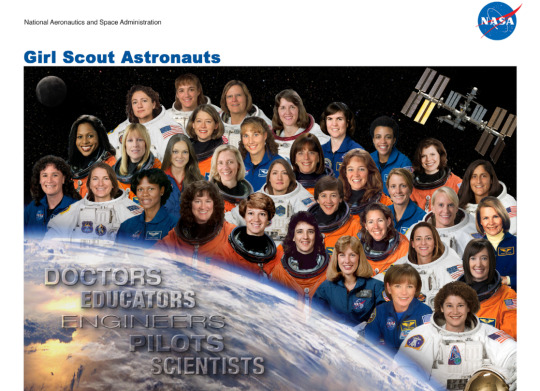
It’s Girl Scout Day! March 12, 2024, is the 112th birthday of Girl Scouts in the United States, and to celebrate, we’re sharing a lithograph of the Girl Scout alumnae who became NASA astronauts.
Girl Scouts learn to work together, build community, embrace adventurousness and curiosity, and develop leadership skills—all of which come in handy as an astronaut. For example, former Scouts Christina Koch and Jessica Meir worked together to make history on Oct. 18, 2019, when they performed the first all-woman spacewalk.
Pam Melroy is one of only two women to command a space shuttle and became NASA’s deputy administrator on June 21, 2021.
Nicole Mann was the first Indigenous woman from NASA to go to space when she launched to the International Space Station on Oct. 5, 2022. Currently, Loral O’Hara is aboard the space station, conducting science experiments and research.
Participating in thoughtful activities in leadership and STEM in Girl Scouts has empowered and inspired generations of girls to explore space, and we can’t wait to meet the future generations who will venture to the Moon and beyond.
Make sure to follow us on Tumblr for your regular dose of space!
#NASA#space#space exploration#Girl Scouts#adventure#explore#inspiration#inspirational women#Womens History Month#WHM#science#STEM#women in STEM#women in science#International Space Station#ISS#astronaut#tech#technology
2K notes
·
View notes
Note
hello ! this is my first hsr req ! can i have dan heng nd blade (separate) with an s/o that somehow made them laugh? (cus yknow both of them are cold and shi😭)
↳ pairing : dan heng & blade x gn reader
↳ synopsis : request ♡
↳ authors note : thought this would be a cute idea, i had tons of fun writing this! i hope you enjoyyy !! ssliiightly suggestive for blade ❔❔that was so harf to write im CRYING!!!

People can't say they aren't surprised over the relationship you and DAN HENG formed over the years you two developed a bond. The seemingly ice-cold Cloud Piercer spending time with the Space Stations researching sweetheart was certainly a sight to see. And while you'd be lively chatting away, Dan Heng was at your side intently listening and inserting his input now and then.
One day, while you two were talking over lunch, you decided to make a really stupid joke while you two were eating.
"Psst. Why did the rocket scientist dump his ex?" Dan Heng blinks a few times in confusion as he drinks his tea, setting it down on the table before sighing. "Weird question.. why?"
"Cause he had no comet-ment!"
You can see his eyes widen slightly, a hand going to his mouth as you can see him muffle a laughter but eventually allows himself to snicker at your horrible joke. "Was that a laugh?!" You smile, standing from your seat while slightly slamming your table in the process. "Did I just get the Dan Heng to laugh?"
He eventually ends his fit of laughter, crossing his arms as he looks at you with a rather endearing look. "Yes yes, you got the Dan Heng to laugh.. whatever that means."
"I got my Dan Heng to laugh, hehehee.." You giggled, walking over to give him a hug as he's happy to return the embrace. "Yeah yeah, you with your corny jokes.."
"Heey..!-"

You weren't entirely sure how to get your stone faced boyfriend to laugh, let alone smile at his own will. The closest thing you've gotten was his hums of pleasure whenever you two would kiss, so maybe thats the way you'll get your boyfriend to smile.
You tap him on the shoulder, catching his attention as he turns his gaze to look at you. Tapping your lips with your index finger and he immediately understands what you're asking, grabbing your hand softly as he brings you to a much more hidden area. "This was sudden." He'll say, caressing your cheek as you smile. "I mean, not like I can predict when I wanna kiss you."
He's more than happy to satisfy that for you, leaning down to kiss you in the exact way you always want. But to his surprise, your hand travels to the back of his head as you pull him close and run your fingers through his hair. You can hear a startled muffle from him amidst the kiss you shared, but his body language clearly showed he was into it. Leaning further in as his hands explore every inch of your body, you can see that he's lost in his own enjoyment.
Blade takes a moment to pull away for a breath of air, and as his forehead is pressed against yours - he lets out a breathless chuckle with a clear smirk across his features.
So you can imagine his confusion when your gaze of passion turned to excitement, pulling away as you smile. "I did it!"
"Did.. what?"
"I got you to laugh! Even with a smile, technically smirk.. but a wins a win!" You hummed, cupping his face in your hands as he sighs. "So that's why.. you could've just asked to see me smile, you know?"
"But wheres the fun in that? I just wanted to see you smile is all."
"You alone make me happy, though I may not show it physically, my actions and heart speak for itself.. so please, my heart asks if we can continue where we left off."
#˚₊· ͟͟͞➳❥ bailu's candy stash#honkai star rail x reader#hsr x reader#dan heng x reader#blade x reader#blade hsr x reader
1K notes
·
View notes